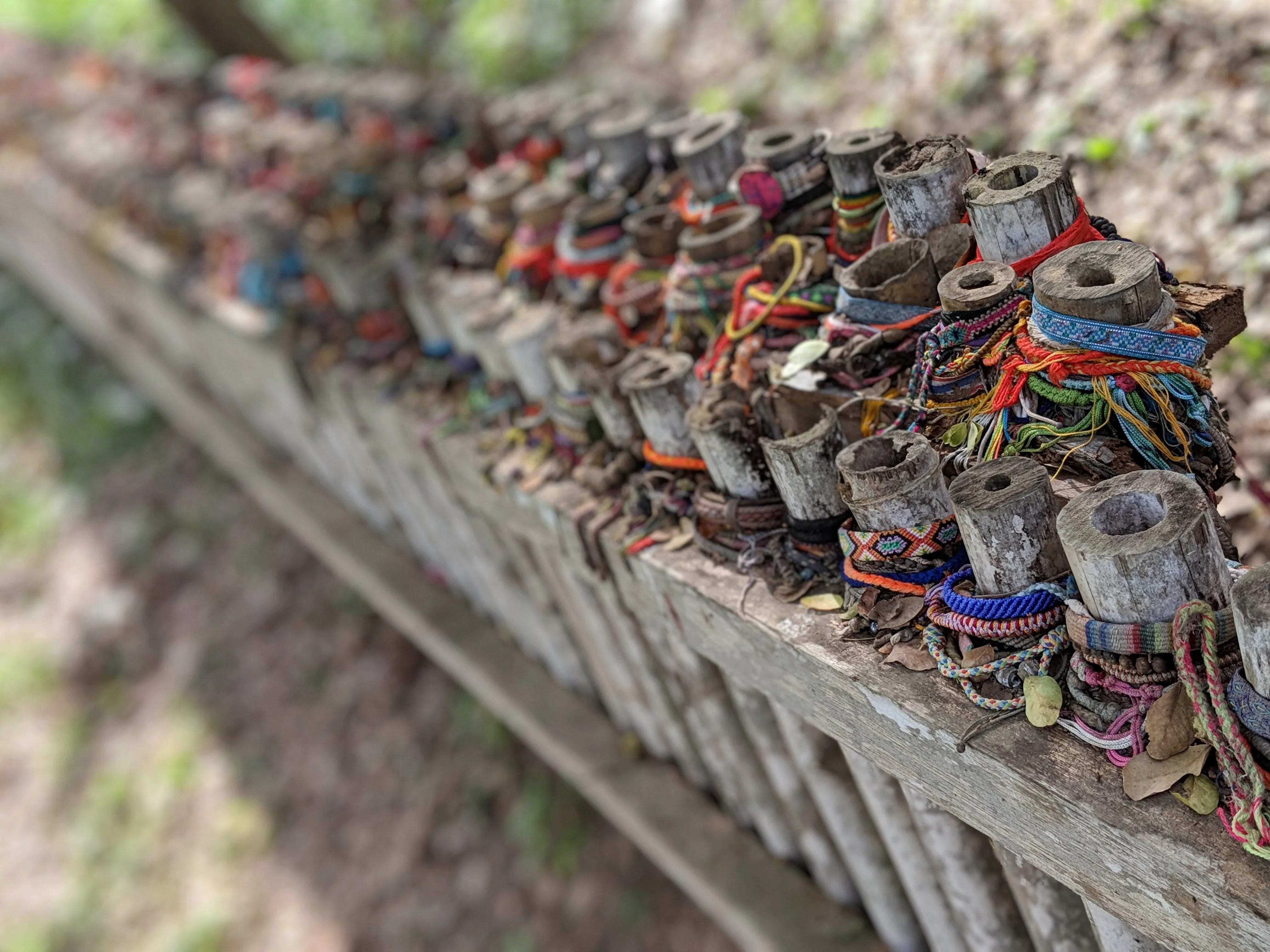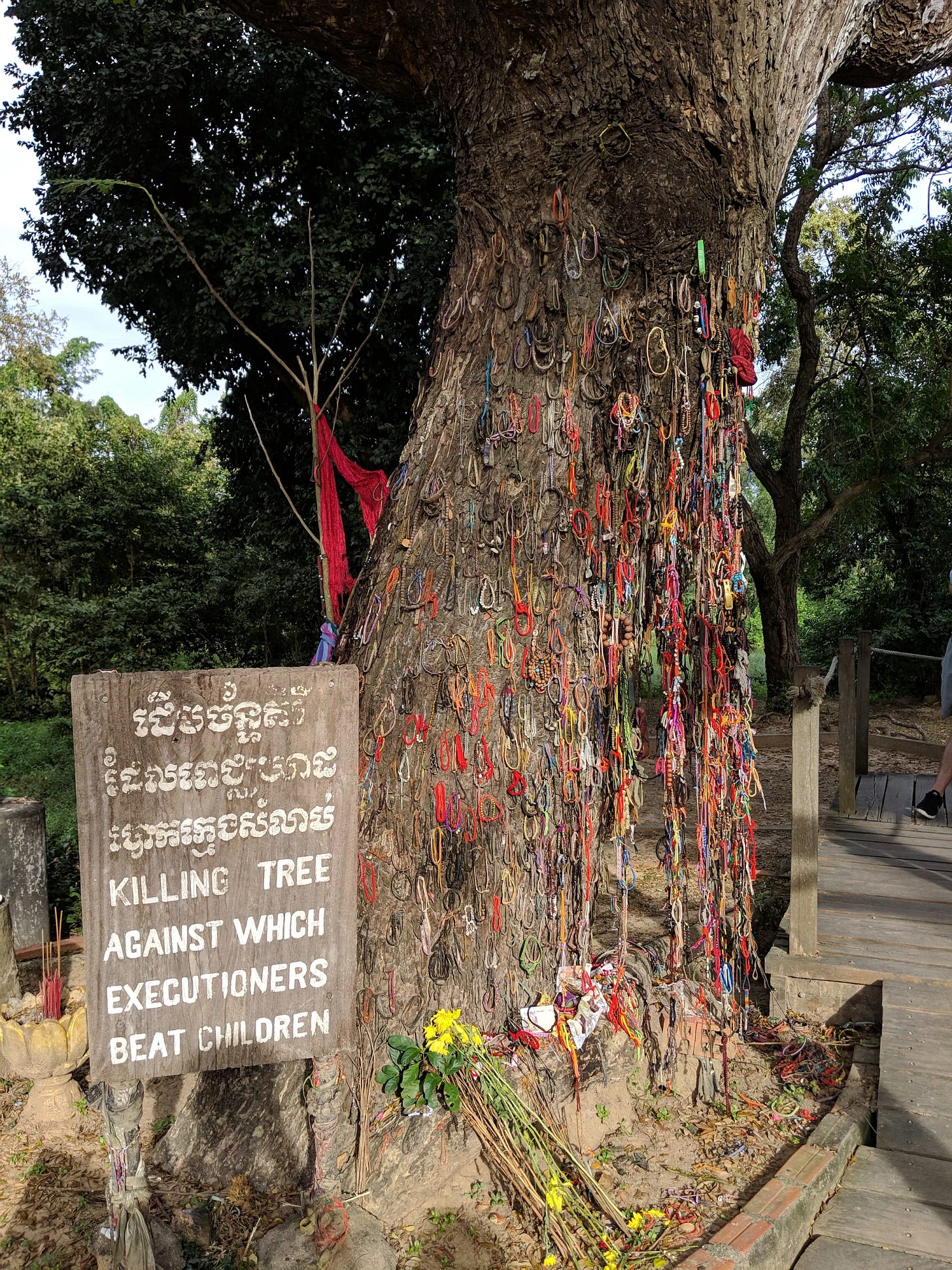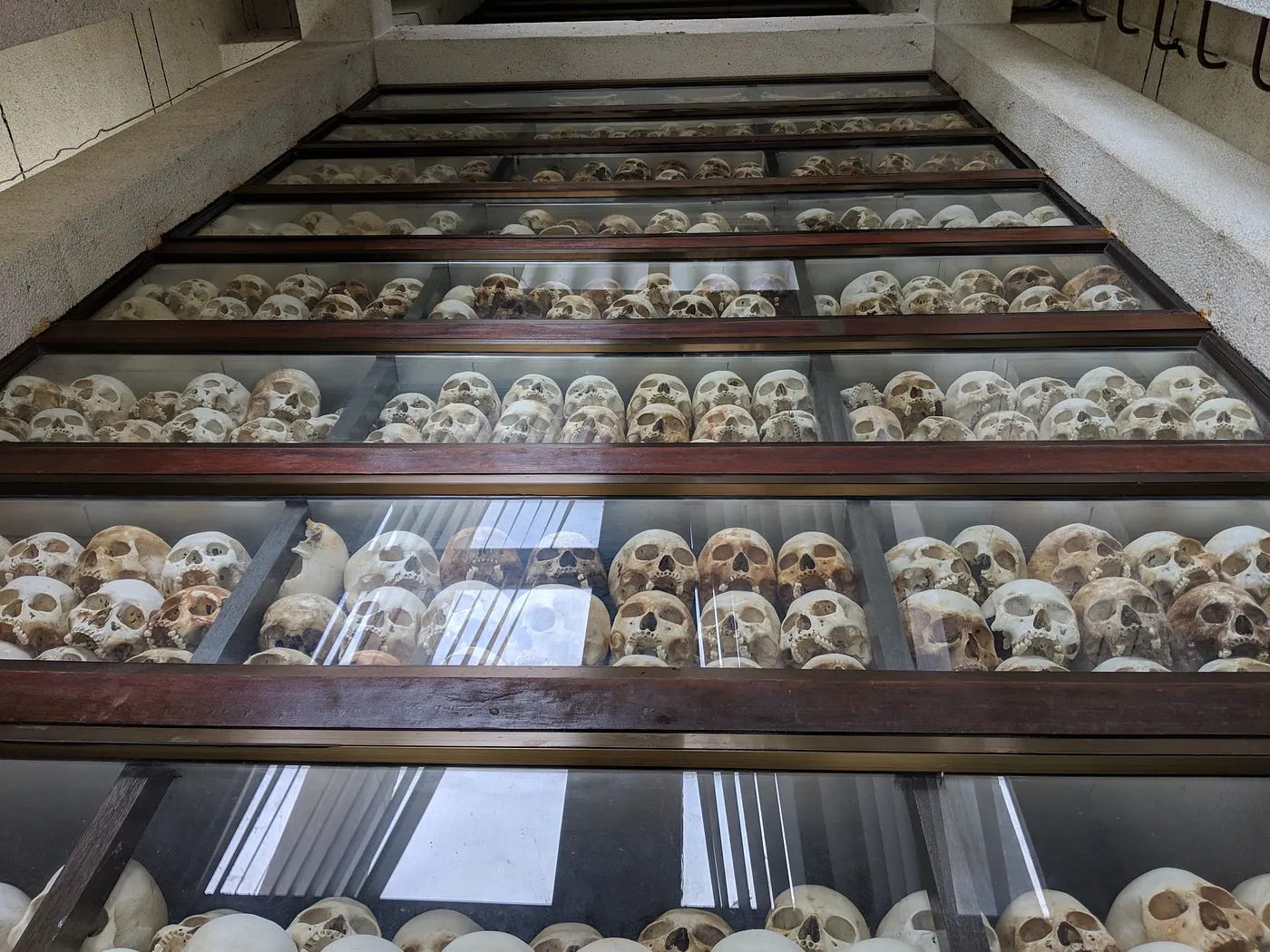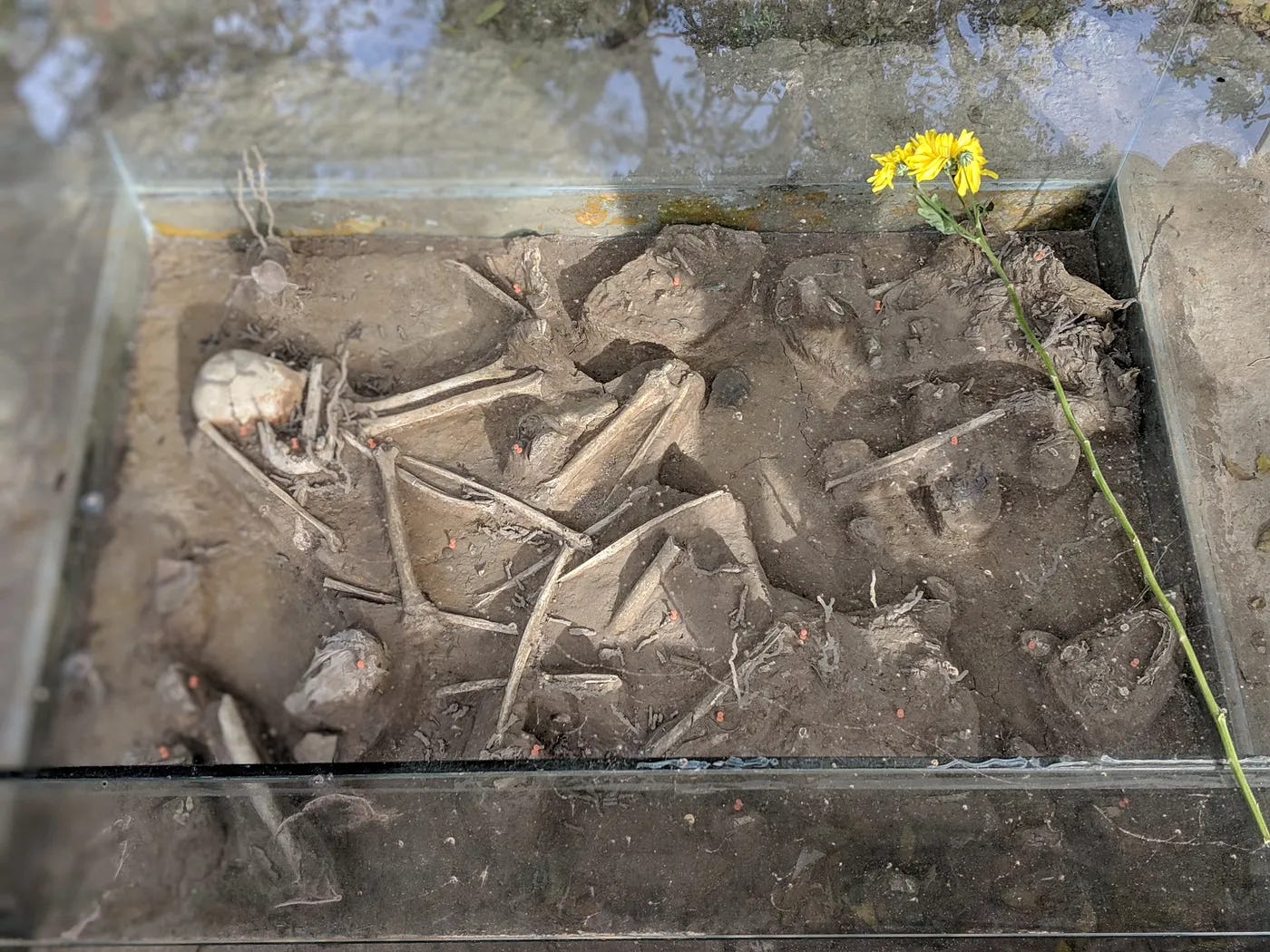Witnessing Death: The Charnel House of Choeung Ek, Cambodia
Reflections from a trip to the Killing Fields in Cambodia.
Disclaimer and Trigger Warning: The following narrative contains graphic descriptions of death, brutality and human suffering, unfortunately, all of which is based on historic records. There are pictures and accounts of the genocide perpetrated on the Cambodian people by the despotic rule of the Khmer Rouge, under the administration of the Angkar, with Pol Pot at the helm. Reader discretion is advised.
Heat rises early in the day in Phnom Penh. It drapes the city like a damp, heavy blanket wrapping around cracked balconies and seeping into the narrow lanes crisscrossing across the bustling metropolis. In the balcony of our hotel room, we sip on an exquisitely fragrant cup of coffee, watching the capital slowly wake up: saffron-robed monks shuffle barefoot, their brass bowls tinkling like wind-chimes; a woman in floral pajamas fans the embers of charcoal beneath some kind of honeyed meats, their warm and welcoming aroma wafting slowly across the neighborhood; tuk-tuks or moto-taxis whine through puddles left by the light predawn shower, misting the air with diesel, mud, and the faint tang of fermented fish. We had planned to start the morning some 23 kilometers south of our hotel, at a former longan orchard called Choeung Ek.
Our tuk-tuk driver arrives at half-past eight, surprising us with his punctuality. His fading grey t-shirt proclaims “Life, Liberty and the Pursuit of Tacos” in Comic Sans – an unexpected echo of Americana halfway across the world. We exchange pleasantries while he vigorously cajoles the reluctant engine to restart. In careful English he tells us that he studies sociology at night and ferries travelers around by day. Eventually, the engine coughs to life, settles into an even hum, and we merge into the motley tide of morning traffic. Weaving in and out of traffic, it does not take long for modern storefronts to dissolve into wooden houses, then to flat green meadows bordering our bumpy ride. By now, the sun is rinsing the fields with molten gold.
After another half an hour of driving out of the city, the tuk-tuk driver taps the chassis and points to a rust-red water tower listing over a line of thatched roofs. “Khmer Rouge made people dig canals there,” he says gently. “No machines. Sometimes only with bare hands. My grandfather had scars.” He traces a line across his forearm with a fingertip. I ask whether he has ever stepped inside Choeung Ek. Without looking away from the road he shakes his head. “Long ago,” he mutters, intently looking away from us. “I don’t really have the time, you know.” We know better than to press for more information. We change topics – how about stopping for some green coconuts? “One dollaah!” – his effervescent smile widens, as he careens to a stop next to a lady selling a giant mound of coconuts. It seems one U.S. dollar is the universal price of stuff here! Thirst quenched, we trundle off into the countryside once again.
A sun-bleached plank finally announces, “CHOEUNG EK GENOCIDAL CENTER”. Beyond the ticket booth stretches a tableau so peaceful that for a minute we wonder if the tuk-tuk driver dumped us somewhere else! Mango and palm trees line pebbled pathways, a pond stippled with lotus leaves, dragonflies skimming the water like fragments of stained glass. Birds chirp; a breeze stirs the palm fronds. At the back of my mind, I wonder – this looks exactly like our ancestral farmhouse in Ranaghat, far away in the villages of West Bengal!
The attendant hands me an audio guide; a soft voice in an even accent starts the narration that will hold us spellbound for the next hour or so: “You are standing where there was once a large and beautiful orchard. But, between 1975 and 1979, more than 17,000 prisoners from Tuol Sleng were executed here.” The matter-of-fact tone hits us like a ton of bricks.
The footpath is partly a warped boardwalk, which eventually gives way to a soft path. Ever so often, like a rebellious distributary, a footstep-worn path takes off from the sides of the main walkway. As we walk in, each step makes the planks groan, as though the earth still objects to our trespassing steps. Little wooden stakes and boards protrude from the grass here and there: Mass grave of 450 victims. Mass grave of headless women. The language is bureaucratic, curt; the horror beneath is boundless. Low mounds rise and fall across the clearing like the swells of a becalmed sea; every hump an excavated pit. A faint, sweet-sour odor of fruits, compost, decayed cloth, lingers on in the air. Is that the smell of death, that hangs on decades down the line? Or perhaps it is just in my head.
Humidity clings to my shirt; crickets chirp away in the canopy overhead. Silence settles with such a density that it feels like a slowly building weight building up all around me. This is not the reverent hush of a cathedral, or the studious silence of a museum. It is an unnatural vacuum swallowing life and breath and thought alike. If hell has a sound, it is this silence.
A white stupa looms at the center, its Khmer-style roof knifing into blue sky. Sunlight flashes off glass panels, revealing row upon row of skulls stacked like ivory votive candles. I climb the tiled steps, press my forehead to the cool pane. My breath fogs the glass for a second, before a placard explaining that the structure shelters more than 8,000 crania, sorted by age and sex, swims into my view. An eerie echo of the regime’s mania for counting. I note that some skulls are punctured by nails, others cleft by machetes or the pointed end of some other instrument of death. One shelf holds delicate infant bones; fontanelles were never meant to meet such violence.
Meanwhile, the narrative in my ear is building up the horror story with a practiced nonchalance. Pol Pot’s cadres rarely used bullets; ammunition cost money. Death had to be efficient. And cheap. The audio voice recites this fact in a soothing timber, but my stomach twists. I imagine the last moments of the people whose remains stand before me: their jolting truck ride from the holding cells of Tuol Sleng, the blindfold, the floodlights, the hot taste of fear. Did they believe the lie that they were being relocated to work camps? Or a court to rule on their crimes against the nation? Did any of them dare to hope? I have not been to Auschwitz or Rwanda, but I think evil leaves its mark where it drops roots as deep as it once did here.
A few paces, away a towering trunk is garlanded in red and yellow string bracelets left by visitors who, like me, have no other language for grief. Its bark is dark and scalloped, as if chunks have been gouged out repeatedly. A weather-cracked sign explains, with cruel simplicity: “Killing Tree Against Which Executioners Beat Children.” The audio track does not even falter, as it continues: To save bullets, cadres swung babies by the ankles and smashed them against this tree. Nearby, excavators had uncovered a pit filled with bodies of naked women and infants, most with skulls fractured or massively deformed. A farmer scavenging cassava unearthed the first remains in 1979; tufts of hair, bone splinters, then entire bodies clutched together in the final throes of a painful end.
The tropical air suddenly tastes metallic. I picture mothers screaming; teenagers in black pajamas, with a mask across their faces, hefting a crying infant like a sack of rice; the wet thwack of bone against wood; silence returning almost as quickly as it was broken. I brace a hand on the tree; the bark is warm, almost soft. The tree stood, witness to this inhumanity.
Just meters away, looms another giant palm, pitted by rusty nail holes. Locals call it the “Magic Tree” because during executions loudspeakers were lashed to its branches, blaring revolutionary anthems loud enough to drown human shrieks. A diesel generator chugged beside it, its exhaust mixing with the smell of blood and wet grass - a poisoned petrichor. The condemned died to the sound of ballads praising Angkar, the all-seeing Organization at Pol Pot’s beck and call.
I wander further. Dragonflies dive-bomb puddles; butterflies settle on wild hibiscus, indifferent to the bones beneath and silenced shrieks around us. Every now and then, heavy rains will coax artifacts to the surface; teeth, buttons, scraps of checkered cloth, bones... Staff collect them quietly, rinse them in bowls of water, and place them in glass display boxes. The ground refuses to forget.
As a physician I am trained to hold death at arm’s length: verify the pulse, note the vital signs, sign the certificate, console the family with rehearsed gentleness. Choeung Ek annihilates that distance. Here death is industrial, ideologically engineered, tallied by spreadsheet. I catch myself cataloguing injuries from reflex – basilar skull fracture, subdural hematoma, pulmonary hemorrhage – and then I recoil at the vulgarity of such clinical shorthand. Violence, too, is a pathogen; it spreads on contact, carried by slogans and silence.
I sink onto a bench under a short mango tree with knobby roots, my knees unsteady. An elderly groundskeeper sweeps leaves nearby, each swipe of his broom like a dry whisper across the path. His straw hat hides most of his face, but his eyes are steady, downcast. I say hello; he mutters back a greeting, then something in Khmer that I cannot understand. He goes on sweeping, and the hush of silence swells and fills up the space around us again.
Afternoon light slants like shafts of bronze across the field. I circle the perimeter pond where defiantly pink water-lilies are in full bloom, their beauty refusing to be extinguished. Near the exit a small altar smolders with jasmine-scented incense. I look for a light to ignite a coil, but I find none; so I bow three times, an awkward benediction to strangers I can neither diagnose nor save.
And I whisper a silent promise to remember. Always.
The stupa doors swing shut behind me with a reverential click. The driver has been idling in his tuk-tuk, tinny Khmer rock leaking from his phone speaker, arms folded under this head, like a makeshift pillow, and legs draped lazily over the vehicle’s gilded fender ornaments. The ride back to Phnom Penh is in a different kind of silence; one broken only by the engine and the rumble of returning traffic. The late afternoon traffic throngs around us; yet we ride with Choeung Ek within us, a phantom perched alongside us on the back seat. I scrub my palms against my trousers as if the chill in the Choeng Ek air has seeped under my nails.
Our next stop is Tuol Sleng. Once a high school, now a museum of terror, its courtyards are eerily spotless. Classrooms hold iron bedframes and leg shackles; chalkboards still bear writing scratched by prisoners forced to confess imaginary plots; roughly hewn walls and cells divide the classroom into small, unventilated, dark prison holding cells. Black-and-white mugshots line the walls; teenage boys in checkered shirts, grandmothers clutching ID plaques, toddlers wide-eyed with confusion. Between fourteen and seventeen thousand inmates entered these gates; fewer than twenty walked out alive. Tuol Sleng was the intake valve; Choeung Ek the disposal chute. Even genocide required paperwork.
Night drapes the city in neon and exhaust and an inexhaustible energy to live in the present. Back in our hotel, Bhavna and I tap the dust out of our shoes, and then we scrub our hands until the skin blanches. It is not dirt we are trying to wash away; it is the proximity to “death by design” we just experienced. We ruminate that evening: We study anatomy on cadavers. We learn to cut without emotion. But these skulls are not specimens. They are warnings.
The word that haunts me is Baksbat, “broken courage” (Chhim, 2013). Cambodian psychiatrists use it to denote a trauma distinct from classic PTSD: chronic fear, numbness, a loss of agency that trickles through generations. Public-health workers here treat dengue and tuberculosis, yes, but also a national nervous system charred by atrocity. Trauma is not metaphor; it is epidemiology.
Justice has limped. The Extraordinary Chambers in the Courts of Cambodia began work in 2003. After more than three hundred million dollars and fifteen years, the tribunal secured only three life sentences. Not that their international counterparts had more success - Pol Pot, the principal architect of this extermination, died of old age, surrounded by his loved ones, family, grandchildren, just like any other old and weary traveler. The Khmer Rouge remained the officially recognized U.N. participants a decade after being overthrown by Vietnamese armies. Justice delayed, as the cliche goes, is justice denied.
Survivors call it too little, too late. Yet locals like our tuk-tuk-driving budding sociologist insist that justice is also collective: We remember, so we don’t repeat. Memory, I think, is like herd immunity here.
On our final evening in the city, we drift along the riverfront where the Tonlé Sap meets the Mekong. Vendors roast corn over charcoal; lines of fish to choose from for dinner; children cartwheel in dust that glitters under streetlamps; monks in saffron robes hover over phone screens capturing the violet-gold sunset. Life here is riotous, resilient, insistent. And yet every April, on the Day of Anger, Phnom Penh pauses. Old sorrows surface, like the bones from Choeng Ek’s monsoon mud, and the city chants requiems instead of pop songs.
Just after dusk, we sit in a café, I am gulping down iced coffee thickened with condensed milk and Bhavna sipping pensively on an egg-white coffee. The tuk-tuk driver materializes, holding a glass of coffee of his own, and a piece of paper working out the total amount that we owed him. Bracing for an astronomic number that we would have to haggle down, I am surprised to be met with a very reasonable figure. As we hand over sundry coins and dollar notes, “What did you learn?” he asks. I search for eloquence, for a thesis on vigilance, on how ordinary men become executioners, how hate mutates like a virus; but the words tangle. “I’m still processing,” I confess. He sips his tea, nods slowly. “Me too,” he says, though he lives the generational trauma every day.
We part at the airport. As the plane lifts through monsoon haze, Choeung Ek shrinks to a green smudge on the outskirts of the capital. I cannot even figure out which way it lies… Yet the field remains inside me, vibrating like a tuning fork whenever the word genocide grazes a headline. Bones keep surfacing after every heavy rain; the ground refuses forgetfulness. The dead are always speaking. The question, is whether we will listen.
If you choose to listen, begin with Elizabeth Becker’s When the War Was Over, Philip Short’s Pol Pot, and David Chandler’s Voices from S-21. Explore the Yale Cambodian Genocide Program’s digital archives; sit with the survivor testimonies. Bones, however eloquent, cannot describe what ears heard on nights when loudspeakers drowned human pleas.
We say never again, as if repetition were impossible. Yet genocides recur. In Rwanda, Darfur, Myanmar, Gaza. Pathogens evolve; and so does hate. The only inoculation is vigilance: to look, to name, to remember until silence itself shouts down the next rallying anthem. May we never tire of honoring the bones that surface. May we heed them before the earth is forced to speak once more.





